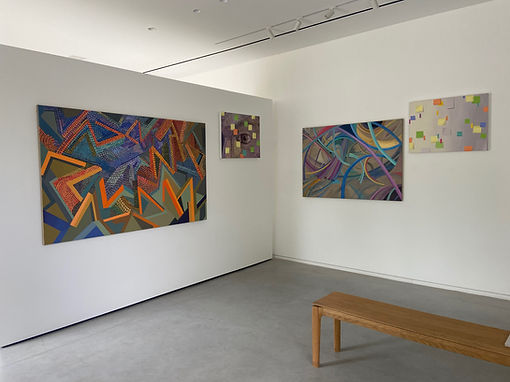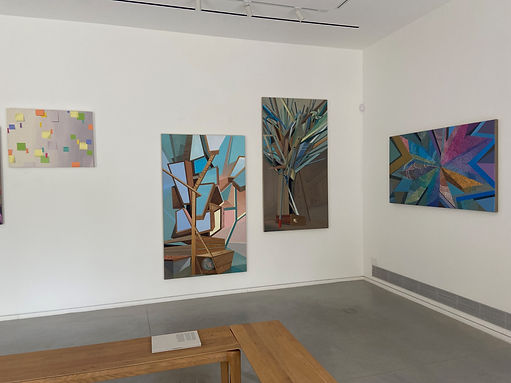
Painting and studio work reflect present-day reality. In the last year, when I felt the world was disintegrating around me, I tried to understand its new forms. To bring to painting a new order that would somehow explain what was happening. To contain the newness and to adjust myself to a new reality that was still seeking its own form.
The exhibition “In The Beginning, a Stone Was Created” presents a new corpus of work, in which adjoining colour splotches create a mosaic-like image. Along with this series, previous works are displayed, which attest to processes and ideas that preceded it.
Cultures, great and small, end in heaps of stone and ruins. The chaos of their end does not differ greatly from what preceded it: the chaos of their beginning. As a basis for my work, I create a pictorial language, which is gradually built up; when it breaks down, it serves as building stones for the next series. This time, I felt my world had to be rebuilt from simple, basic forms: from one stone next to another. I found comfort in a splotch of colour placed in a specific location, with a predetermined shape and size. As the painting developed, the small stones joined to form a new and complex whole, falling apart and reforming at the same time, describing an image of a smashed compass or a psychedelic explosion. Out of the instability, I succeeded in creating order and images that reflected what I was thinking about – a re-examination of ideas, values, conscience and ideology.
The work of painting requires inner peace, which makes it possible to concentrate and process ideas. While I was working, however, reality kept knocking on my studio door. Between the news flashes, the phone calls with my parents during missile alerts, the war and the demonstrations, knowing I was too far away and nonetheless close at the same time, my work mocked me. When I gathered all my efforts in order to concentrate, to overcome my complicated mental state, I felt as if the paintings were laughing at me and at my efforts to rally them into some internal and ideological order. The shape of the Hebrew letter khet (ח), which I used to set the boundaries of every stone I painted, echoed in my mind as the guttural laughter of the painting itself: kha-kha-kha…
In the beginning, stone was created. Hard and cold, but with the beauty of creation concealed within it. It is an aggregation of elements from the vast spaces of the universe. It can be mingled in infinite combinations, and an infinity of meanings can be drawn from it.
It embodies the simple and the exalted – the material and, despite its weight, the spiritual.
In the beginning, a stone was created – and stone is the essence of all. It is magical, and that magic is most revealed when it joins other stones to mark a path, to erect a building, to leave a remnant of a glorious past and cosmic knowledge of the future. Remove one stone from the others, and you disturb the fabric of existence. Once that fabric is dismantled, it will take an eternity to search for the missing pieces – and an eternity to reconnect them and create something old and new. The possibility of seeing their meanings and understanding their depths will become more remote. Once the whole is dismantled, the stamp of destruction will mark its parts forever. The edges of the stone will erode and become blunted. They will never connect smoothly again.
And its colors will fade and disappear into the darkness on the face of the deep.





